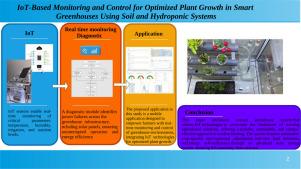基于物联网的监测和控制,利用土壤和水培系统优化智能温室中的植物生长
IF 7.6
3区 计算机科学
Q1 COMPUTER SCIENCE, INFORMATION SYSTEMS
引用次数: 0
摘要
背景:气候变化、自然资源枯竭和全球粮食安全的迫切需要给农业带来了越来越大的压力。智能技术,特别是支持物联网的温室系统,为可持续地加强作物生产提供了一条有希望的途径。然而,实现无缝实时监测、自主控制和故障检测在技术上仍然很复杂,特别是在基础设施有限、能源供应不稳定的偏远或离网地区。目的:本研究旨在开发一种集实时环境监测、自适应控制和嵌入式故障诊断于一体的全自主智能温室系统。一个关键的焦点是通过太阳能自主在离网条件下实现连续可靠的运行。该系统旨在提高从小农地块到商业规模经营的各种农业环境下的作物生产力、能源效率和抗灾能力。方法:系统集成分布式传感器网络、集中控制平台和移动接口,监测温度、湿度、二氧化碳浓度、光照强度、灌溉流量、营养成分和电气参数等关键农艺和技术变量。为了实现预测性维护,实现了一个基于隔离森林算法的异常检测模块,并对合成的多变量时间序列数据进行了训练,这些数据代表了实际故障场景(例如,辐照度下降、过热、传感器漂移、电压不平衡)。采用混淆矩阵、受试者工作特征(ROC)曲线和分类指标对算法的性能进行定量评估,实现了较高的异常检测精度。为每个监测参数分配预定义的警报阈值,并与机器学习输出集成,以提高诊断可靠性。该系统还具有太阳能收集子系统,可连续跟踪光伏电压、电流、能量产出和电池充电状态,支持完全自主的离网运行。结果与结论:受控环境测试表明,该系统能够自主、精确地调节温室气候参数,同时在模拟故障和能量波动场景下确保运行连续性。集成的故障检测模块具有较高的诊断准确性,并且集成了可视化分析以支持非专业用户的可解释性。尽管仍处于预部署阶段,但这些结果证实了该系统的技术稳健性和现场试验就绪性。通过与现有解决方案的对比分析,强调了该系统的独特贡献,即将实时环境控制与嵌入式能源自诊断相结合,解决了当前智能温室技术的一个关键空白。意义:本研究提出了一种新型的集成智能温室架构,解决了可持续农业的关键挑战,包括能源自主、系统弹性和智能环境控制。通过结合实时监控、基于机器学习的故障检测和太阳能供电操作,该系统提供了可扩展的模块化解决方案,可适应各种农业环境。它的设计特别适合面临能源不稳定和气候压力的地区,有助于实现气候适应型、精准农业和全球粮食安全的更广泛目标。本文章由计算机程序翻译,如有差异,请以英文原文为准。

IoT-based monitoring and control for optimized plant growth in smart greenhouses using soil and hydroponic systems
Context:
Agriculture is under mounting pressure from climate change, natural resource depletion, and the urgent need for global food security. Smart technologies, particularly IoT-enabled greenhouse systems, offer a promising pathway to sustainably intensify crop production. However, achieving seamless real-time monitoring, autonomous control, and fault detection remains technically complex, especially in remote or off-grid regions with limited infrastructure and unstable energy supply.
Objective:
This study aims to develop a fully autonomous, intelligent greenhouse system that integrates real-time environmental monitoring, adaptive control, and embedded fault diagnosis. A key focus is on enabling continuous and reliable operation in off-grid conditions through solar energy autonomy. The system is designed to enhance crop productivity, energy efficiency, and resilience across a range of agricultural contexts, from smallholder plots to commercial-scale operations.
Methods:
The system integrates a distributed sensor network with a centralized control platform and mobile interface to monitor key agronomic and technical variables, including temperature, humidity, concentration, light intensity, irrigation flow, nutrient composition, and electrical parameters. To enable predictive maintenance, an anomaly detection module based on the Isolation Forest algorithm was implemented and trained on synthetically generated multivariate time series data representing realistic fault scenarios (e.g., irradiance drop, overheating, sensor drift, voltage imbalance). The algorithm’s performance was quantitatively assessed using confusion matrices, receiver operating characteristic (ROC) curves, and classification metrics, achieving high anomaly detection accuracy. Predefined alert thresholds were assigned to each monitored parameter and integrated with machine learning outputs to enhance diagnostic reliability. The system also features a solar energy harvesting subsystem with continuous tracking of photovoltaic voltage, current, energy yield, and battery state-of-charge, supporting fully autonomous, off-grid operation.
Results and Conclusions:
Controlled-environment testing demonstrated the system’s ability to autonomously and precisely regulate greenhouse climate parameters while ensuring operational continuity under simulated fault and energy fluctuation scenarios. The integrated fault detection module showed high diagnostic accuracy, and visual analytics were incorporated to support interpretability by non-specialist users. Although still in the pre-deployment phase, these results confirm the system’s technical robustness and readiness for field trials. A comparative analysis with existing solutions emphasizes the system’s unique contribution—namely, the integration of real-time environmental control with embedded energy self-diagnosis, addressing a critical gap in current smart greenhouse technologies.
Significance:
This study presents a novel, integrated smart greenhouse architecture that addresses key challenges in sustainable agriculture, including energy autonomy, system resilience, and intelligent environmental control. By combining real-time monitoring, machine learning–based fault detection, and solar-powered operation, the proposed system offers a scalable and modular solution adaptable to diverse farming contexts. Its design is particularly suited to regions facing energy instability and climate stress, contributing to the broader goal of climate-resilient, precision agriculture and global food security.
求助全文
通过发布文献求助,成功后即可免费获取论文全文。
去求助
来源期刊

Internet of Things
Multiple-
CiteScore
3.60
自引率
5.10%
发文量
115
审稿时长
37 days
期刊介绍:
Internet of Things; Engineering Cyber Physical Human Systems is a comprehensive journal encouraging cross collaboration between researchers, engineers and practitioners in the field of IoT & Cyber Physical Human Systems. The journal offers a unique platform to exchange scientific information on the entire breadth of technology, science, and societal applications of the IoT.
The journal will place a high priority on timely publication, and provide a home for high quality.
Furthermore, IOT is interested in publishing topical Special Issues on any aspect of IOT.
 求助内容:
求助内容: 应助结果提醒方式:
应助结果提醒方式:


